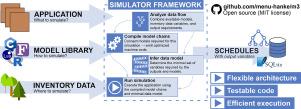A lightweight dataflow-based software framework for building forest simulators
IF 4.6
2区 环境科学与生态学
Q1 COMPUTER SCIENCE, INTERDISCIPLINARY APPLICATIONS
引用次数: 0
Abstract
Simulators are critical tools for decision-making in forest management. We propose a dataflow-based model linking approach to increase the flexibility and modularity of forest simulator software while maintaining high computational efficiency. Our approach dynamically constructs a data model and model chains for simulation based on a model library, enabled treatments, and requested output variables. Models are framework- and language-independent pure functions, described through metadata in a domain-specific language. A case study with three model libraries demonstrates the applicability and efficiency of our approach. We observed a 96% speedup compared to an unoptimized real-world model implementation, while 95% of our code (measured by lines) was framework-independent and reusable. We observed a 15% slowdown compared to an optimized hand-written C implementation of a simpler model. We conclude that dataflow-based model linking can be used to build flexible and modular simulation software with a small runtime overhead.

一个轻量级的基于数据流的软件框架,用于构建森林模拟器
模拟器是森林管理决策的重要工具。我们提出了一种基于数据流的模型链接方法,以增加森林模拟器软件的灵活性和模块化,同时保持较高的计算效率。我们的方法基于模型库、启用的处理和请求的输出变量动态构建数据模型和模型链。模型是独立于框架和语言的纯函数,通过特定于领域语言的元数据进行描述。一个包含三个模型库的案例研究证明了我们的方法的适用性和有效性。与未优化的实际模型实现相比,我们观察到96%的加速,而95%的代码(以行数衡量)是框架独立的和可重用的。我们观察到,与一个更简单模型的优化的手写C实现相比,速度降低了15%。我们得出的结论是,基于数据流的模型链接可以用于构建灵活的模块化仿真软件,并且运行时开销很小。
本文章由计算机程序翻译,如有差异,请以英文原文为准。
求助全文
约1分钟内获得全文
求助全文
来源期刊

Environmental Modelling & Software
工程技术-工程:环境
CiteScore
9.30
自引率
8.20%
发文量
241
审稿时长
60 days
期刊介绍:
Environmental Modelling & Software publishes contributions, in the form of research articles, reviews and short communications, on recent advances in environmental modelling and/or software. The aim is to improve our capacity to represent, understand, predict or manage the behaviour of environmental systems at all practical scales, and to communicate those improvements to a wide scientific and professional audience.
 求助内容:
求助内容: 应助结果提醒方式:
应助结果提醒方式:


